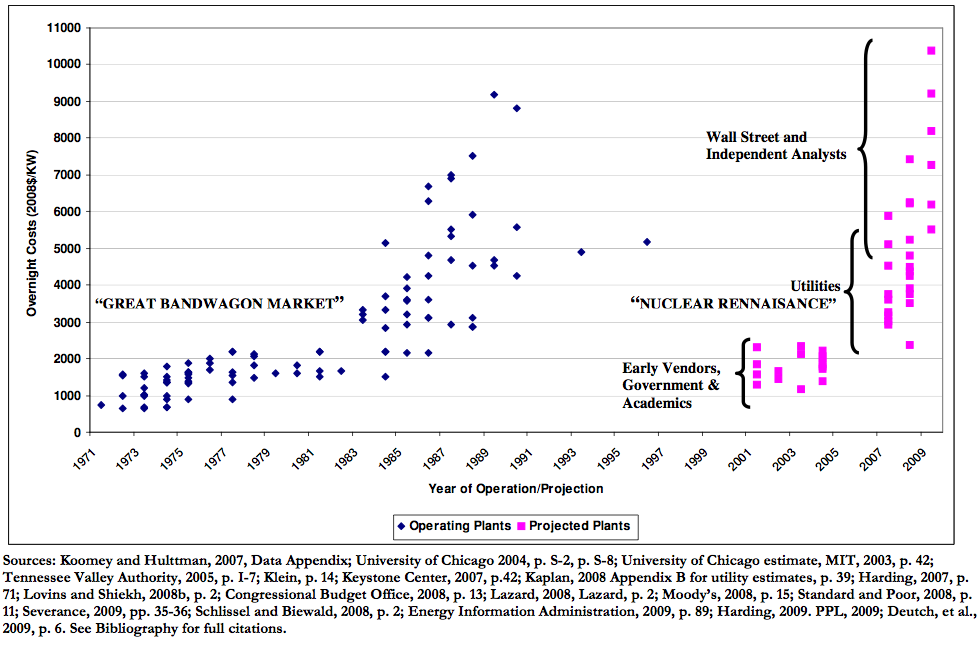I was careful to point that out, you'll notice. I'm glad you brought up the point as you did, however since it offers the perfect opportunity to discuss how spin is practiced by the nuclear industry and its supporters.
Through the middle of the last decade, the *very nuclear friendly* MIT study was LAUDED by nuclear proponents as the last word on the state of the nuclear industry. It's conclusions regarding future costs of plants and electricity production were wielded with savage glee by the Acolytes of Uranus as they tried to convince a skeptical public of the need for nuclear instead of renewables.
But karma really is a bitch and, in reality, instead of falling from the then $2500/kw cost to a predicted average of $1500/kw by 2010, the price actually rose to the range of $8000/kw.
Talk about being red-faced! MIT is still trying to get over that.
Now, on the surface that might seem to be reason to agree with you that the MIT study is wrong on the proliferation issue. But if one were to conclude that they would be doing so only because they were unfamiliar with WHY MIT's projections were so wrong.
You see, the problem with their study was that they had uncritically used uncorrected nuclear industry data as a basis for all of the fundamentals in their paper. Other, independent researchers who looked at the nuclear industry data also made predictions but theirs were far more accurate than the MIT study.
Why you ask? Because they they looked outside the nuclear industry to the historical record of performance and compared that with the claims for the future the nuclear industry was making.
 http://www.olino.org/us/articles/2009/11/26/the-economics-of-nuclear-reactors-renaissance-or-relapse
http://www.olino.org/us/articles/2009/11/26/the-economics-of-nuclear-reactors-renaissance-or-relapseThe problem with the uncritical nature of MIT's methodology was so bad that it prompted a paper in an ethics journal on the nature of the conflict of interest that surrounds much of the academic work done by nuclear friendly researchers.
www.nd.edu/~kshrader/ksf-cv-dec-1-2009.pdf
So, even this *EXTREMELY NUCLEAR INDUSTRY FRIENDLY STUDY* concluded that
cost, safety, waste, and proliferation were problems that HAD to be solved BEFORE we turned to nuclear power as a solution to our problems. BASED ON INDUSTRY CLAIMS OF WHAT IT NEEDED they recommended certain policy avenues that were supposed to help get the industry on its feet as a viable, stand alone economic endeavor.
The governments of both Bush and Obama gave them EVERYTHING THEY ASKED FOR AND MORE.
It isn't enough. They STILL can't make nuclear power work as a cost effective way to boil water in order to make electricity; and you can be damned sure that the language used in the MIT conclusion regarding proliferation is wrong as it too relies upon the same type of nuclear-industry-looking-thru-rose-colored-glasses predictions regarding future technologies and human behavior that underpinned the cost estimates.
The Daily Times, Pakistan Sunday, July 30, 2006
PAKISTAN SAYS NUCLEAR SITE SAFE IN OUR HANDS
KUALA LUMPUR: Foreign Minister Khurshid Ahmad Kasuri said on Friday that a powerful new nuclear reactor under construction was safe in our hands and would not spark an arms race with rival India.
Its nothing new, the world knows about it, the world knows that its safe in our hands, Kasuri told AFP in an interview late Friday at a meeting of Asias top security forum in Kuala Lumpur. Its five years old, its nearing completion now, I dont know the timing, he added. The United States has urged Islamabad not to use the reactor at the Khushab nuclear complex to bolster its atomic weapons capability.
International observers reacted with alarm after the Washington Post on Monday reported the reactors existence, citing the US-based International Institute for Science and International Security.
The group that said satellite photographs showed the heavy water reactor could produce more than 200 kilogrammes of weapons-grade plutonium a year enough to make 40-50 nuclear weapons every year.
Pakistan remains at the heart of an investigation into a nuclear black-market headed by its disgraced chief nuclear scientist, Abdul Qadeer Khan, who confessed in 2004 to passing atomic secrets to Iran, Libya and North Korea.
Kasuri, speaking at the Association of Southeast Asian Nations (ASEAN) Regional Forum, did not specify whether or not the new nuclear plant would be used to produce nuclear weapons.
http://www.democraticunderground.com/discuss/duboard.php?az=view_all&address=364x1773958TTFN